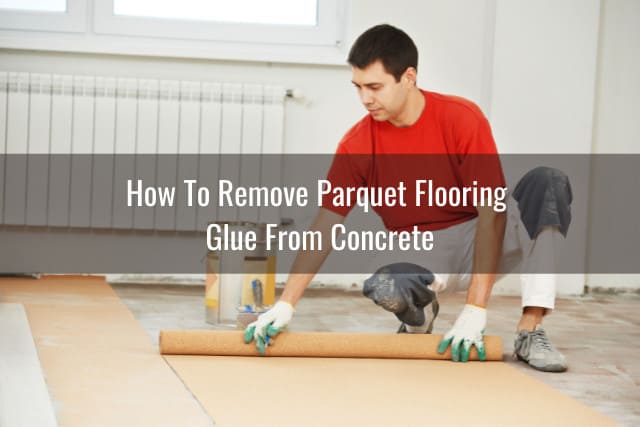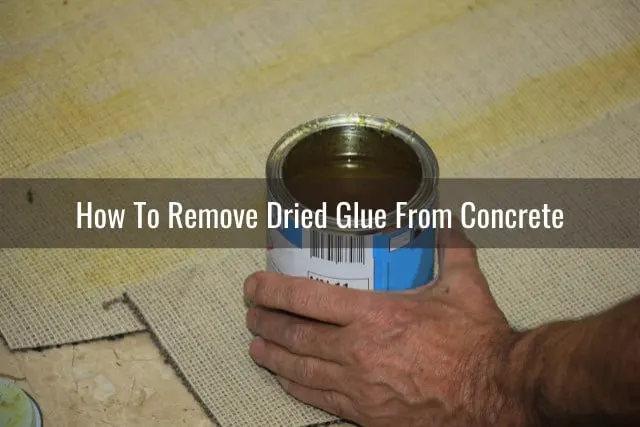Ever spilled a bottle of glue on your concrete floor? It can feel like a major disaster, leaving you with a sticky, impossible-to-remove mess. But fear not! With the right approach and a little elbow grease, you can vanquish that glue and restore your concrete to its former glory.

Image: readytodiy.com
This guide will equip you with the knowledge and techniques to tackle glue removal on concrete floors. Whether it’s super glue, wood glue, construction adhesive, or any other adhesive, we’ll explore effective methods, cautionary tips, and the best tools to get the job done. So, let’s dive in and reclaim your floor from the sticky grip of glue!
Understanding the Glue Situation: A Closer Look at Concrete and Adhesives
Before we embark on the removal process, it’s important to understand the nature of both concrete and glue. Concrete is a porous material, which means it has tiny holes that can trap liquids, making it difficult to remove stubborn stains. Adhesives, on the other hand, are formulated to bind materials together, often with strong chemical bonds.
The type of glue, its age, and the type of concrete flooring all play a role in determining the most effective removal method. For instance, fresh glue spills are generally easier to tackle than hardened glue that has been on the floor for several days or weeks.
Essential Tools and Materials: Getting Ready for the Battle Against Glue
Having the right tools and materials at your disposal will make the glue removal process smoother and more efficient. Here’s a list of items you may need:
- Gloves: Protect your hands from the chemicals used.
- Safety Glasses: Shielding your eyes is essential during any cleaning project.
- Old Rags: For applying solvents and wiping away residues.
- Plastic Scraper: To remove hardened glue, especially for larger spills.
- Putty Knife: Can be used for scraping off stubborn glue residue.
- Dull Knife or Tool: For gently scraping off glue without damaging the concrete surface.
- Bucket: For mixing solutions and holding water.
- Cleaning Agent: Choose the right cleaning agent based on the type of glue. Some commonly used options are:
- Acetone: Effective for many types of adhesives, but it can also damage some surfaces.
- Mineral Spirits: A gentler solvent effective for removing oil-based adhesives.
- Denatured Alcohol: A good option for removing glue residue from porous surfaces.
- White Vinegar: Can be used for removing water-based glue stains.
- Baking Soda Paste: Can help to loosen glue and lift stains.
- Commercial Glue Remover: There are many commercial glue removers available, specifically formulated for removing different types of glue.
Tackling Glue Spills: Step-by-Step Removal Techniques
Now that we’ve gathered the tools, let’s dive into the removal process. Remember, the approach will vary slightly depending on the type of glue. But the general principles remain the same. Here’s a detailed, step-by-step guide:

Image: readytodiy.com
1. Preparation: Protecting Yourself and Your Surroundings
Before you begin, protect yourself and your surroundings. Wear gloves and safety glasses to prevent chemical exposure and potential eye irritation. Cover any nearby furniture or items that you don’t want to be affected by the cleaning solution.
2. Assessing the Glue: Identifying the Enemy
Take a look at the glue on your concrete floor. Is it fresh or dried? What type of glue is it? Knowing the nature of the glue will help you choose the most effective removal method.
3. Removing Fresh Glue: Attacking the Problem Before It Hardens
For fresh glue spills, time is your ally. The faster you act, the easier the cleanup. Here’s what you can do:
- Blot Excess Glue: Use a dry rag or paper towel to blot up as much of the excess glue as possible. Avoid spreading the glue around, and work from the edges inward.
- Apply a Cleaning Agent: Choose an appropriate cleaning agent based on the type of glue. Apply the cleaner to a rag or paper towel and gently rub the glue. Work in small sections at a time.
- Rinse and Repeat: Once the glue softens, rinse the area with clean water and repeat the process until all the glue is removed.
4. Confronting Hardened Glue: Dealing with Stubborn Adhesives
For dried glue, you may need a more aggressive approach. Here’s a breakdown of methods for dealing with hardened glue:
- Scrape Loose Glue: Use a plastic scraper or a dull knife to carefully scrape off any loose or softened glue. Work cautiously to avoid scratching the concrete surface.
- Apply Cleaning Agent: Soak the glue with a cleaning agent suitable for the type of glue. Let it sit for 5-10 minutes to allow the solvent to penetrate and loosen the adhesive.
- Repeat Scrape and Soak: Repeat the scraping and soaking process until all the glue is gone. You may need to apply more rounds of cleaning agent and scraping over several hours.
5. Removing Super Glue: A Unique Challenge
Super glue is notoriously difficult to remove, especially on porous surfaces like concrete. Here are some tips specific to super glue removal:
- Acetone: Soak a cotton ball or rag in acetone and place it directly on the super glue. Let it sit for a few minutes, then try to gently peel off the softened glue. Be cautious, as acetone can damage some surfaces.
- Nail Polish Remover: If you’re careful and have acetone-based nail polish remover on hand, it can be an effective solution. Apply it to a cotton ball or rag and follow the same procedure as with acetone.
- Sanding: As a last resort, if other methods fail, you can try sanding the super glue off with fine-grit sandpaper. Work carefully and be aware that sanding can slightly roughen the concrete surface.
6. Dealing with Epoxy: A More Robust Approach
Epoxy is a strong adhesive that bonds tightly to concrete. Removing epoxy requires more effort and specific tools.
- Mechanical Removal: Epoxy is often difficult to dissolve, so you may need to resort to mechanical methods. A chisel and hammer can be used to break apart larger epoxy chunks. Be incredibly careful to avoid damaging the concrete.
- Epoxy Remover: Consider using a commercial epoxy remover designed for this purpose. Follow the product’s instructions carefully.
7. Removing Glue from Grout: Additional Considerations
If the glue has spilled onto the grout lines of your concrete floor, you’ll need to be extra careful. Here are some tips:
- Cleaning Agent: Apply a cleaning agent directly to the grout line, using a toothbrush or a small scrub brush. Avoid using harsh chemicals or abrasive tools that can damage the grout.
- Grout Cleaning Tools: Consider using a grout cleaning tool or a grout brush specially designed for cleaning grout lines.
- Patience: Be patient; it may take several passes and soakings to remove all the glue from the grout.
Finishing Touches: Bringing Back the Shine
Once you’ve successfully removed the glue, take a moment to clean up any remaining residue and restore the floor to its best condition.
- Rinse with Water: Carefully rinse the affected area with clean water to remove any traces of cleaning agents or glue residue.
- Dry the Floor: Use a clean rag or a mop to dry the floor completely.
- Seal the Concrete: To protect the concrete from future stains and wear, consider applying a sealant to the floor after it has dried completely.
Safety First: A Reminder of Precautions
Always prioritize your safety when dealing with chemicals and tools. Here are some essential precautions:
- Ventilation: Work in a well-ventilated area to minimize exposure to fumes.
- Protective Gear: Always wear gloves and eye protection when handling cleaning agents.
- Instructions: Carefully read and follow the manufacturer’s instructions for any cleaning agents or tools you use.
- Testing: If you’re unsure about a cleaning agent on your concrete floor, test it in a small, inconspicuous area first.
- Children and Pets: Keep cleaning agents and tools out of reach of children and pets.
How To Get Glue Off Concrete Floor
The Takeaway: From Sticky Mess to Pristine Floor
Removing glue from a concrete floor may seem daunting, but with the right tools, techniques, and a bit of patience, it is a task you can conquer. Remember to choose the appropriate cleaning agent based on the type of glue, work cautiously, and prioritize your safety. By following the steps outlined in this guide, you can effectively remove glue spills and restore your concrete floor to its original condition. So, next time you encounter a sticky situation, remember that with a little knowledge and effort, you can reclaim your floor from the clutches of glue!






